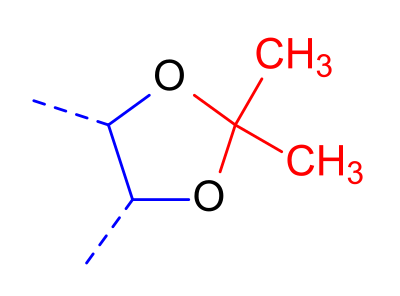
Search
Acetonide

In organic chemistry, an acetonide is the functional group composed of the cyclic ketal of a diol with acetone. The more systematic name for this structure is an isopropylidene ketal. Acetonide is a common protecting group for 1,2- and 1,3-diols. The protecting group can be removed by hydrolysis of the ketal using dilute aqueous acid.
Example
The acetonides of small di- and triols, as well as many sugars and sugar alcohols, are common. The hexaol mannitol reacts with 2,2-dimethoxypropane to give the bis-acetonide, which oxidizes to give the acetonide of glyceraldehyde:
- (CHOHCHOHCH2OH)2 + 2 (MeO)2CMe2 → (CHOHCHCH2O2CMe2)2 + 4 MeOH
- (CHOHCHOCH2OCMe2)2 + [O] → 2 OCHCHCH2O2CMe2 + H2O
An example of its use as a protecting group in a complex organic synthesis is the Nicolaou Taxol total synthesis. It is a common protecting group for sugars and sugar alcohols, a simple example being solketal.
The acetonides of corticosteroid are used in dermatology, because their increased lipophilicity leads to better penetration into the skin.
- Fluclorolone acetonide
- Fluocinolone acetonide
- Triamcinolone acetonide
See also
- Acetophenide
- Acroleinide
- Aminobenzal
- Cyclopentanonide
- Pentanonide
References
Text submitted to CC-BY-SA license. Source: Acetonide by Wikipedia (Historical)
Articles connexes
- Triamcinolone acetonide
- Fluocinolone acetonide
- Fluclorolone acetonide
- Topical steroid
- Triamcinolone
- Algestone acetonide
- Corticosteroid
- Fluocinolone
- Keloid
- Descinolone acetonide
- ATC code D07
- List of corticosteroids
- Intravitreal injection
- Flupamesone
- Acetal
- 2,2-Dimethoxypropane
- Prednisone
- Cortisol
- Desonide
- Betamethasone dipropionate
Owlapps.net - since 2012 - Les chouettes applications du hibou

